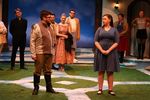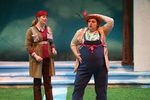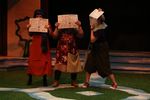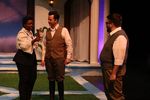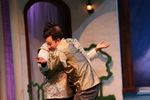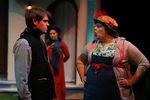Education Guide - Villanova Theatre
←
→
Page content transcription
If your browser does not render page correctly, please read the page content below
Education Guide
Villanova Theatre, 2017-18 Season
Created by Megan Schumacher, Education Dramaturg, mschum10@villanova.edu
Production Photos courtesy of Ann Marley, Villanova Theatre Marketing
Cartoon and Character Chart courtesy of Alexandra Curth, Production DramaturgWelcome to the Villanova Theatre Education Guide for our
production of Much Ado About Nothing. This resource is intended to
help individuals, educators, and students gain additional insight into
the production. It includes discussion questions to consider before
seeing the show as well as after, and suggested activities to help you
engage with the show on a more intimate level.
TABLE OF CONTENTS
Synopsis……………………………….…......2
Introduction to the Characters….……....…..3
About the Playwright……………….…...…...4
Design…………..........................…...……..4-5
Language…………….……………………….6
Humor…………….…………………………...7
Love………………….…...…………………...8
Villainy………………………………………...9
Gender Roles………………………………..10
Seeing the Show…………………………….11
1Synopsis
Act I - Leonato learns that Don Pedro and his men are to arrive shortly to Messina after a victorious war. Upon arrival,
Don Pedro arranges to stay in Messina for a month, Benedick and Beatrice renew their war of words, and Don Pedro
agrees to woo Hero for Claudio. Upon hearing that Don Pedro is going to help win Hero’s heart for Claudio, the
villainous Don John plots to undermine the marriage proposal.
Act II - At the masked ball, Don John tells Claudio that Don Pedro has wooed Hero for himself; however, his lie is
exposed, and Claudio and Hero agree to marry each other. After the ball, in the garden of Leonato’s estate, Don Pedro,
Claudio, and Leonato convince a hiding Benedick that Beatrice secretly loves him.
Act III - Hero and Ursula arrange for Beatrice to overhear their discussion of Benedick’s secret love for her. In his
second plot to undermine his brother, Don John arranges, with the help of one of his men, Borachio, to defame Hero’s
good name and present her as unchaste to Claudio and Don Pedro. The watch overhear Borachio bragging about Don
John’s plot and bring him before the constable, Dogberry. On the wedding morning, Dogberry tries to inform Leonato of
the plot, but fails.
Act IV - At the altar, believing she has been unchaste, Claudio rejects Hero, and with the help of the Prince, shames her
publicly. Upon hearing of his daughter’s behavior, Leonato threatens to disown her, but the Priest proposes a means of
restoring her good name. In order to do so, Hero is to be said to have died in grief. The act ends with Benedick and
Beatrice privately declaring their love to each other, and Benedick promises to avenge Hero’s death for Beatrice’s sake.
Act V - After revealing that Don John lied about Hero and has fled Messina, Benedick challenges Claudio to a duel, and
Borachio confesses Don John’s plot to the authorities. Hearing that Hero has died due to his wrongful accusations,
Claudio promises to make amends. He does so by mourning Hero’s death with a tribute and agreeing to marry Hero’s
cousin, who happens to look like her. Claudio’s new bride is revealed to be Hero, and Beatrice and Benedick’s love for
each other is made public. All the couples prepare to marry each other.
2Introduction the Characters
Beatrice, the niece of Leonato, smart and sassy, is a loyal friend to Hero and worthy combatant with words for
Benedick. While admired by the Prince, her love will ultimately be sworn to another.
Benedick, a gentleman and soldier under Don Pedro, is much admired by Claudio and much disdained by Beatrice. His
promise to never marry is challenged by his friends who are determined to see him love.
Hero, the only child of Leonato and cousin to Beatrice, is courted and eventually engaged to Count Claudio. She is
intended to be the model of womanhood within the play.
Claudio, a young Count, having proven his mettle on the battlefield in Don Pedro’s army, has earned the Prince’s
favor. Upon arriving in Messina, he falls in love with the only daughter of Leonato, Hero.
Leonato, the Governor of Messina, father to Hero, and uncle to Beatrice, acts as host to Don Pedro and his men, as
well as Don Pedro’s brother, Don John.
Don Pedro, the Prince of Arragon, having just won a battle against his half brother, Don John, arranges
accommodations to house his men in Messina at the house of his old friend, Leonato.
Don John, the half-brother of Don Pedro, he is also known as the bastard. Though the Prince believes he and Don
John are reconciled, Don John continues to hold a grudge against his brother and schemes to undermine him.
Dogberry, the Master Constable of Messina, due to his excessive use of malapropisms, is a clown without knowing he
is a clown. While he takes his job seriously, his failure to use language properly, makes it astonishing that he
accomplishes what he does.
(Additional Characters: Verges, Conrade, Borachio, Ursula, Margaret, Antonio, Friar Francis, Balthasar, George
Seacoal, Sexton)
3About the Playwright
The prolific playwright, William Shakespeare (1564-1616), wrote more than thirty plays and 154 sonnets. Among his
plays were histories (Henry V and Julius Caesar), comedies (Twelfth Night and Comedy of Errors), tragedies (Hamlet
and King Lear), and romances (A Winter’s Tale and The Tempest). Much Ado About Nothing is one of his comedies. It
is believed to have been written and performed in 1598 by Shakespeare’s company, The Lord Chamberlain’s Men,
during the reign of Queen Elizabeth I, and was staged again in 1612 by Shakespeare’s company, The King’s Men, at
the court of King James for a royal wedding celebration.
Design
Both the set and costumes for the Villanova production of Much Ado About Nothing are inspired by the Elizabethan
stage. Both are a fusion of modern and Elizabethan. The set is designed to be an airy space, not locked in by shapes
and form, and the costumes incorporate elements of Elizabethan fashion, including ruff collars, bodices with corset
boning, quilted doublets and doublets with fitted cap sleeves. The intention of both the set and costumes is to create a
playful, whimsical world for the play. Watch a behind-the-scenes video about Villanova’s set-design.
4Design (Continued)
Post-Show Discussion Question and Activity:
1. The set designer, Parris Bradley, wanted a set not locked in by shapes and form. How is this accomplished?
What does this set have or not have that allows for unobstructed movement?
2. In your classroom, create a space to play with two chairs. Assign two people to perform the roles of Claudio and
Benedick. Below are lines from Act I, scene 1. Have the two actors perform the piece with both chairs on stage, then
just one chair on stage, and finally no chairs on stage. Check in with the performers and class to see how each pass
through the text changes and informs the choices the actors make on stage when performing the excerpt from the
scene.
CLAUDIO. Benedick, didst thou note the daughter of
Signior Leonato?
BENEDICK. I noted her not, but I looked on her.
CLAUDIO. Is she not a modest young lady?
BENEDICK. Do you question me as an honest man
should do, for my simple true judgment? Or would
you have me speak after my custom, as being a
professed tyrant to their sex?
CLAUDIO. No, I pray thee, speak in sober judgment.
BENEDICK. Why, i’ faith, methinks she’s too low for a
high praise, too brown for a fair praise, and too
little for a great praise. Only this commendation I
can afford her, that were she other than she is, she
were unhandsome, and being no other but as she is,
I do not like her.
CLAUDIO. Thou thinkest I am in sport. I pray thee tell
me truly how thou lik’st her.
BENEDICK. Would you buy her that you enquire after
Her? Can the world buy such a jewel?
CLAUDIO. Yea, and a case to put it into.
BENEDICK. But speak you this with a sad brow? Come, in
what key shall a man take you to go in the song?
CLAUDIO. In mine eye she is the sweetest lady that ever
I looked on.
(1.1.158-84)
5Language
Much Ado About Nothing, like all of Shakespeare’s plays, consists of two types of styles: prose and verse. Both serve
distinct purposes for those speaking. In Much Ado, 7 out of every 10 lines is prose! In prose speech, the language is
irregular with no line-endings. According to Giles Block’s Speaking the Speech, prose is the language of characters who
are attempting to hide their feelings, entertain each other, or appear witty. It is also the language used to make jokes.
Knowing the extent to which characters try to hide their feelings of love in this play (Benedict and Beatrice) and attempt
to plot against each other (Don John) - it is not surprising that most of the language of Much Ado is prose.
Verse is rarer in Much Ado compared to prose, but there is still plenty of it. Shakespeare wrote his verse in iambic
pentameter. This means that each line of verse is made up of five two-syllable feet, with the first syllable of each foot
unstressed and the second syllable. When Ursula and Hero are tricking Beatrice into believing that Benedick loves her,
Ursula says:
Ursula’s lines are an example of blank verse because they do not rhyme, and as you can see by the slashes between
the words and syllables, there are five, two-syllable feet per line. In the first line, the syllables — why, you, doth, the,
and tle — are unstressed, while the syllables — did, so, not, gen, man — are stressed. The curved mark above the
syllable denotes an unstressed syllable, while the slash above denotes a stressed syllable. Iambic pentameter is said to
echo the beat of your heart. This makes sense, as according to Giles Block, verse is used when characters are being
sincere and speaking from the heart. Even though Ursula is tricking Beatrice in this example, she is speaking from the
heart, in order to convince Beatrice of Benedick’s true love.
Prose gives way to verse in Much Ado during serious moments. For example, during Claudio’s shaming of Hero,
Claudio begins speaking in verse, and the other characters join him, including Benedick and Beatrice.
Pre or Post Show Activity:
Practice a scansion of the following lines from Hero:
O god of love! I know he doth deserve
As much as may be yielded to a man,
But Nature never framed a woman’s heart
Of prouder stuff than that of Beatrice. (3.1.49-52)
Place a slash between every two syllables, and denote the stressed and unstressed syllables. Once you have done so
practice delivering the lines. Another option is to set up ten chairs across a classroom. Each participant should take a
seat and be assigned one of the syllables from a line. Upon their turn, they should say their syllable, remaining seated if
the syllable is unstressed and standing if the syllable is stressed.
6Humor
Tied to language is Shakespeare’s word play. Shakespeare loved a good laugh, and there are many to be had in
Much Ado About Nothing. While a lot of the laughs are found in the language, whether they are clearly delivered is
entirely upon the actors. So much of the laughter found in Shakespeare is not only about how the actor delivers the
line, but also in the gesture that comes with the line. For example, there is quite a bit of bawdy humor in Much
Ado. Specifically, there are a number of penis jokes, but as a modern day audience, some of the references to
man’s genitalia might get lost if the actor doesn’t make some sort of gesture to convey what he or she is
referencing.
In addition to the bawdy humor, there’s also the humor found in those who misuse the English language. Dogberry
is one of Shakespeare’s funniest characters because of his use of malapropisms. He is constantly misusing words
that sound like the word he intended. For example, in Act 3, scene 5, he states, “Our watch, sir, have indeed
comprehended two auspicious persons," when what he means to say is “Our watch, sir, have apprehended two
suspicious persons.”
Post-Show Discussion Questions:
1. What lines did you hear in a new way? What lines did not sound particularly Shakespearean?
2. Besides language, what is used to create humor in the production? Where are the laughs created by the
actors/director?
3. How does pacing affect humor? Pay attention to when lines are delivered quickly versus when lines are
delivered.
7Love
In a 2018 article in Psychology Today, Dr. Theresa DiDonato writes, “The kind of qualities that are known to reflect love
— intimacy, commitment, passion — are not particularly strong in those first moments when people say they've fallen in
love at first sight. At least, these emotions are not experienced to the same degree as they are by people in established
relationships. The extent to which people in relationships report feeling intimacy and commitment and passion toward
their partners far exceeds reports of these emotions by people who experience love at first sight. Yet the love-at-first-
sight experience appears open to these emotions to a greater extent than first meetings where love at first sight is not
reported.” (DiDonato, Theresa E., Ph.D, “Is Love at First Sight Real?” Psychology Today. 27 Jan 2018.)
Much Ado About Nothing is riddled with current and former lovers and love of all types. In Act 1, Claudio is smitten with
Hero upon first seeing her, and both Benedick and Beatrice, having had some sort of relationship in the past, have
sworn off love. Benedick, in particular, has a negative response to the idea of marriage equating it with having a “yoke”
around one’s neck. Yet, upon hearing that Beatrice is love with him in Act 2, he is overcome with love for her, and she
for him in Act 3 when she hears he is love with her.
As for Claudio and Hero, barely any words are passed between the two of them, and yet she agrees to marry him. Also,
even after he has mistaken her for another woman, humiliated her by falsely accusing her of being with another man,
and insulted her by calling her a “rotten orange” and “common stale,” she agrees to marry him a second time.
Post-Show Discussion Questions:
1. Based on the performances you saw on stage, who is the more in love? Benedick and Beatrice or Claudio and
Hero? How do the performances help inform the audience that each couple is in love?
2. Do you think anything else besides love is motivating the partnering of the two couples? Based on what you saw
and heard, what besides love might be driving them to marry?
8Villainy
Much is made about the villainy of Don John, Don Pedro’s “bastard”
brother. Benedick refers to Don John as a bastard three times, and all
three times it is to capture his character. Benedick’s logic suggests
that because Don John is a bastard, he is a villain. The audience is to
understand that the battle Don Pedro and his men are returning from
as victors was one started by Don John, that Don John did something
of which the “legitimate” brother, Don Pedro, did not approve. But
what the act was that led to the campaign between brothers is never
revealed. The only details regarding the brothers are that Don Pedro
was victorious and is “reconciled” with his brother.
It is very clear, however, that Don John is not reconciled with Don
Pedro. From the moment he arrives in Messina, he is plotting to
undermine his brother, and he finds a way to do so with the help of
Borachio, who arranges a way to tarnish Hero’s name. The fact that
Claudio and Don Pedro believe Don John seems to call into question
Don John’s villainy. Indeed, why would either of them believe Don
John? Yet they do, twice!!! And the second time they do so, they do so
with little evidence other than a sighting of the back of a woman at
Hero’s window in the dark of night.
Pre or Post-Show Discussion Questions:
1. In order to perform the role of Don John, Alexandra King had to come up with the backstory of her character. It
was a necessary tool so that she had a clear motivation for his actions. What do you imagine generated the
fight between the brothers: Don John and Don Pedro? What is Don John’s story?
2. What makes Don John a villain and not Claudio or the Prince? What do you make of Beatrice’s rant against
Claudio when she asks rhetorically: “Is he not approved in the height a villain / that hath slandered, scorned,
dishonored my kinswoman?”(4.1.315-16)? Her commentary on Claudio’s behavior suggests Don John may
not be the only villain. Do you agree? Who do you think is a villain? Why?
3. During the rehearsal for the play, members of the cast joked about making “Free Conrade” t-shirts, as Conrade
is arrested even though he did not help Borachio in his plan. What does justice look like in this play? Is there
any justice? If you were to play judge and jury in the world of Much Ado, who would you punish and what
would their punishments look like? Who would you exonerate? Why?
9Gender Roles
Shakespeare has much to say about gender and the proper behavior of men and women in Much Ado About
Nothing. On page and in performance, it is difficult to ignore the seemingly silent Hero and her foil and cousin, the witty
Beatrice. In Shakespeare’s world, it is Hero who is the exemplar of the two women. She is a model for her cousin and
other women. While Hero is described as sweet, worthy, and fair, Beatrice is described as a shrew and harpy. For men,
Shakespeare holds up men who are good, obedient soldiers, which Claudio and Benedick model. Benedick further
models this when he agrees to defend Hero against the slander of Claudio, Don Pedro, and Don John.
Post-Show Discussion Questions:
1. The Villanova production has cast characters across genders. What, if anything, is the Villanova production
saying about gender?
2. Does the Villanova production uphold Shakespeare’s perspective on gender, or does it undermine it? How so?
10Seeing the Show
Villanova Theatre is excited to have you join us for Much Ado About Nothing. We want to offer a few reminders
concerning theatre etiquette so that you will experience the best from the actors and production team who have worked
hard to create the show for you.
1. Remember to silence or turn off your phone. Please do not place phones on vibrate because this, too, often
makes a noise that can be distracting to those around you as well as the performers.
2. Do not send or receive texts during the production. Taking out your phone during the performance to check a text
or to send one is distracting to those in the surrounding seats due to the light coming from your phone.
3. Do not take photographs during the performance. This is for the safety of our performers as well as laws
surrounding intellectual property. Best to sit back and enjoy the show, taking a mental image for your memory.
4. Refrain from opening candy wrappers or anything that is going to make a noise. This is distracting for those
around you who are trying to listen to the performance as well as the actors who are working to create a world on
the stage. Please open any candy wrappers or tissue containers or other items that could potentially make a noise
before the show begins.
5. Refrain from talking. Again, this is distracting to those around you as well as the actors on stage. When on
stage, it is often thought the actors are too far from the audience to hear what is happening. This is far from the
truth. More often, actors can hear every movement, laugh, and spoken word.
6. Finally, please refrain from touching actors during the performance. Because Vasey Theatre is a thrust stage,
actors often cross in front of audience members. Unless you are invited to do so, you should not touch them.
Thank you so much for making your Villanova Theatre experience the best for all involved.
11You can also read


